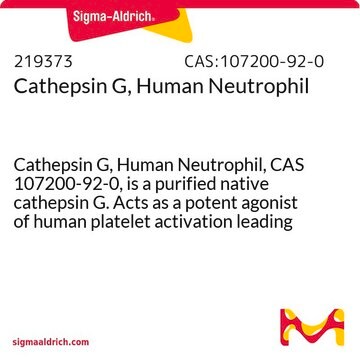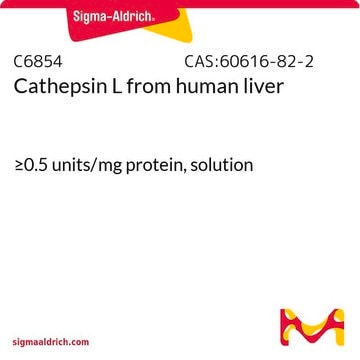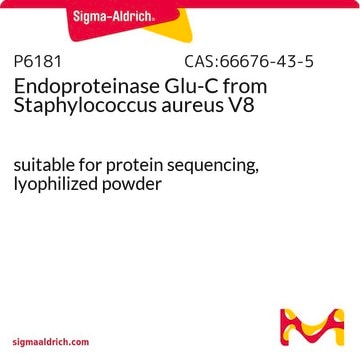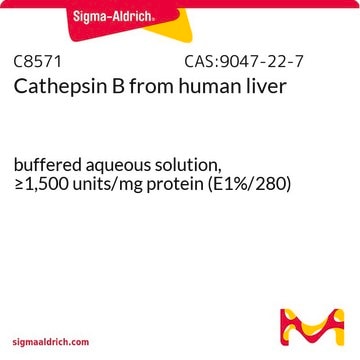219402
Cathepsin L, Human Liver
Cathepsin L, Human Liver, CAS 60616-82-2, is a native, the most potent of all the lysosomal proteinases. Plays a major role in the proteolysis of both cellular and endocytosed macromolecules.
Synonym(s):
CTSL, CTSL1, Human Cathepsin L, Major excreted protein (MEP)
Sign Into View Organizational & Contract Pricing
All Photos(1)
About This Item
Recommended Products
biological source
human liver
Quality Level
form
liquid
manufacturer/tradename
Calbiochem®
storage condition
OK to freeze
avoid repeated freeze/thaw cycles
technique(s)
activity assay: suitable
suitability
suitable for molecular biology
application(s)
life science and biopharma
shipped in
wet ice
storage temp.
−70°C
Gene Information
human ... CTSL(1514)
General description
Research area: Cell Signaling
Cathepsin L, Human Liver, native, is the most potent of all the lysosomal proteinases. Cathepsin L (CTSL) belongs to the papain subfamily of cysteine proteases and is mainly located in endolysosomal vesicles.
Cathepsin L, Human Liver, native, is the most potent of all the lysosomal proteinases. Cathepsin L (CTSL) belongs to the papain subfamily of cysteine proteases and is mainly located in endolysosomal vesicles.
Biochem/physiol Actions
Cathepsin L (CTSL) has higher activity than cathepsins B and H in the degradation of a variety of physiological protein substrates. It is believed to be responsible for the generation of endostatin from the NC1 domain in collagen XVII. It is responsible for regulating cell cycle, nucleotide-binding domain, leucine-rich–containing family, pyrin domain–containing-3 (NLRP3) inflammasome activation, proteolytic processing of Bid during apoptosis, and TGF-β signaling. It can degrade a wide range of proteins, encompassing enzymes, receptors, and transcription factors. Additionally, it produces active enzymes, receptors, and biologically active peptides through controlled proteolysis. Moreover, Cathepsin L has been observed to enhance tumor cell migration by lowering cell-cell adhesion and breaking down elements of the extracellular matrix. The expression of CTSL escalates in several types of cancers, including glioma, melanoma, pancreatic, prostate, and breast cancer. It plays a major role in the proteolysis of both cellular and endocytosed macromolecules.
Packaging
Please refer to vial label for lot-specific concentration.
Warning
Toxicity: Standard Handling (A)
Unit Definition
One unit is defined as the amount of enzyme that will hydrolyze 1.0 µmol of Z-FR-AFC per min at 25°C, pH 5.5.
Physical form
In 400 mM NaCl, 20 mM malonate buffer, 1 mM EDTA, pH 5.5.
Preparation Note
Prepared from tissue of individuals that have been shown by certified tests to be negative for HBsAg and for antibodies to HIV and HCV.
Reconstitution
Following initial thaw, aliquot and freeze (-70°C).
Other Notes
Note: 1 mU = 1 milliunit
Legal Information
CALBIOCHEM is a registered trademark of Merck KGaA, Darmstadt, Germany
Storage Class Code
12 - Non Combustible Liquids
WGK
WGK 2
Certificates of Analysis (COA)
Search for Certificates of Analysis (COA) by entering the products Lot/Batch Number. Lot and Batch Numbers can be found on a product’s label following the words ‘Lot’ or ‘Batch’.
Already Own This Product?
Find documentation for the products that you have recently purchased in the Document Library.
Tulasi Yadati et al.
Cells, 9(7) (2020-07-17)
Cathepsins are the most abundant lysosomal proteases that are mainly found in acidic endo/lysosomal compartments where they play a vital role in intracellular protein degradation, energy metabolism, and immune responses among a host of other functions. The discovery that cathepsins
Blockage of Lysosomal Degradation Is Detrimental to Cancer Cell Survival: Role of Autophagy Activation
Schwartz-Roberts JL and Clarke R
Autophagy: Cancer, Other Pathologies, Inflammation, Immunity, Infection, and Aging, 121-133 (2015)
Cathepsin L
Kirschke H
Handbook of Proteolytic Enzymes, 2.0, 1808-1817 (2013)
Targeting Cathepsin L in Cancer Management: Leveraging Machine Learning, Structure-Based Virtual Screening, and Molecular Dynamics Studies
Almalki AA, et al.
International Journal of Molecular Sciences, 24(24), 17208-17208 (2023)
Zsanett Jancsó et al.
Gastroenterology, 158(4), 1083-1094 (2019-11-22)
Mutations in the human serine protease 1 gene (PRSS1), which encodes cationic trypsinogen, can accelerate its autoactivation and cause hereditary or sporadic chronic pancreatitis. Disruption of the locus that encodes cationic trypsinogen in mice (T7) causes loss of expression of
Our team of scientists has experience in all areas of research including Life Science, Material Science, Chemical Synthesis, Chromatography, Analytical and many others.
Contact Technical Service








